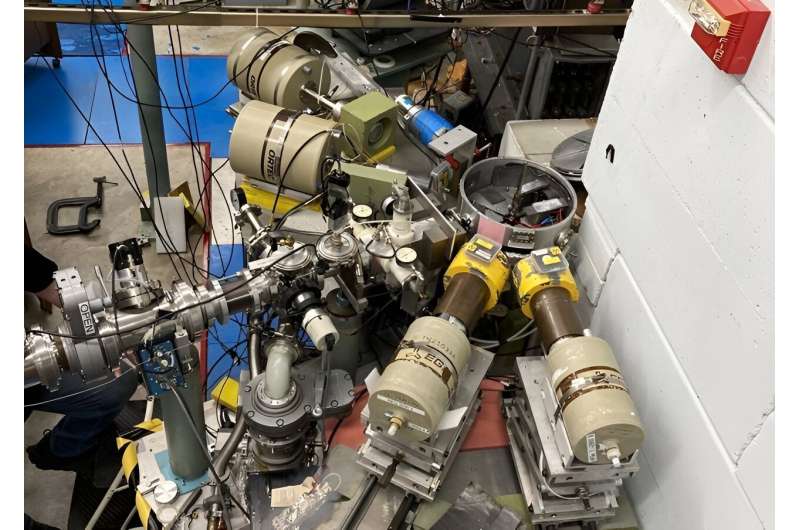This article has been reviewed according to Science X's editorial process and policies. Editors have highlighted the following attributes while ensuring the content's credibility:
fact-checked
peer-reviewed publication
trusted source
proofread
Discovery of low-lying isomeric states in cesium-136 has applications in particle astrophysics

Large, low-background detectors using xenon as a target medium are widely used in fundamental physics, particularly in experiments searching for dark matter or studying rare decays of atomic nuclei. In these detectors, the weak interaction of a neutral particle—such as a neutrino—with a xenon-136 nucleus can transform it into a cesium-136 nucleus in a high-energy excited state.
The gamma rays emitted as the cesium-136 relaxes from this excited state could allow scientists to separate rare signals from background radioactivity. This can enable new measurements of solar neutrinos and more powerful searches for certain models of dark matter. However, searching for these events has been difficult due to a lack of reliable nuclear data for cesium-136. Researchers need to know the properties of cesium-136's excited states, which have never been measured for this isotope.
This research, appearing in Physical Review Letters, provides direct determination of the relevant data by measuring gamma-ray emission from cesium-136 produced in nuclear reactions at a particle accelerator. Importantly, this research reveals the existence of so-called "isomeric states"—excited states that exist for approximately 100ns before relaxing to the ground state.
In modern particle physics experiments, the delayed emission of gamma rays from these states will show up as a separate, distinct signal from the initial reaction. This creates a clear signature in the data that allows researchers to reject background noise and unambiguously identify these types of rare interactions.
A team of researchers from Lawrence Berkeley National Laboratory, the SLAC National Accelerator Laboratory, the University of North Carolina—Wilmington, and Duke University has performed new measurements of the excited states in cesium-136 using the tandem accelerator at the Triangle Universities Nuclear Laboratory (TUNL).
The researchers created the excited cesium-136 by bombarding a target of xenon-136 gas with a pulsed beam of protons. They detected the resulting gamma-ray emission using four high-purity germanium detectors surrounding the target.
The experiment measured both the energy of the gamma rays and their detection times relative to the beam pulse, allowing the team to reconstruct the level structure of the cesium-136 nucleus and to measure the lifetimes of the excited states involved in the gamma-ray emission. Two of the excited states are identified as nuclear isomers with lifetimes of 95 and 157 nanoseconds.
These data enable researchers for the first time to reliably model the emission of gamma rays induced by so-called "charged-current" nuclear interactions in large xenon detectors. This opens a new channel for detecting astrophysical neutrinos and possible dark matter candidates.
Several major experiments that are currently running (including LZ, XENONnT, and KAMLAND-Zen) can immediately begin searching for these events in their data. Next-generation experiments such as nEXO or XLZD, which will contain more xenon-136, may be uniquely sensitive to low-energy components of the solar neutrino spectrum such as neutrinos from the carbon-nitrogen-oxygen (CNO) cycle.
More information: S. J. Haselschwardt et al, Observation of Low-Lying Isomeric States in Cs136 : A New Avenue for Dark Matter and Solar Neutrino Detection in Xenon Detectors, Physical Review Letters (2023). DOI: 10.1103/PhysRevLett.131.052502
Journal information: Physical Review Letters
Provided by US Department of Energy




















